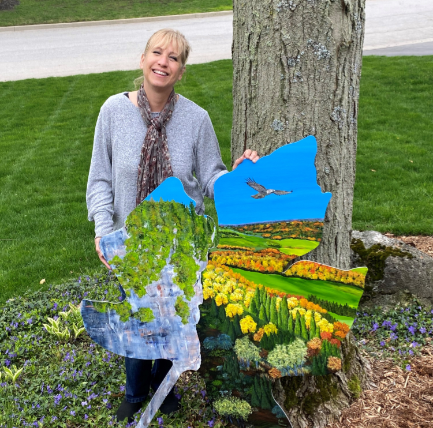By Maisha Hasan, Local Journalism Initiative Reporter
As spring blossoms from the ground, so do the bevy of artists emerging with their work, through over thirty pieces of sculptural work displayed in downtown Burlington that comprise the Burlington Waterfront Sculpture Trail. A dazzling mirage of metal and clay, sculptures thread the Art Gallery of Burlington, Spencer Smith Park, and Downtown Burlington BIA on Brant Street together by art.
This trail is a project of the Dan Lawrie International Sculpture Collection (DLISC), whose decade-long mission has been supporting the art of sculpture and its creators. DLISC pays artists from across Canada to exhibit their work and then provides further support by working to sell their artworks. Dan Lawrie is the Burlington-based founder and chairman of the Lawrie Insurance Group.
This year, the exhibition continues until June 1, and viewers can vote for their favourite work. Audience voting is open throughout the exhibit’s duration; the winner will receive $1500.
Ranging widely in size and materials used, the works chosen for this year’s Burlington Waterfront Sculpture Trail (BWST) highlight the creativity and skill of the artists. You may have noticed, for instance, Quebec-based artist Nate Nettleton’s work entitled “Disco Ball” in Spencer Smith Park, visible as you drive along Lakeshore Rd. Or walking along Brant St., you may have seen Paula Hartman’s “Dancing Blossoms” or Brendan Duggan’s “Infestation” in Buzz Barber and Co.’s window.
Some works can be found inside buildings — Brendan Lee Satish Tang’s “Manga Ormolu Version 4.0” can be viewed inside the Pearle Hotel and Spa, and Christopher Reid Flock’s “Basking Denim Noise” sits inside City Hall.
The 2 km trail is fully accessible; guidebooks can be picked up from the Tourism Burlington Visitor Information Centre, Art Gallery of Burlington, Joseph Brant Museum, City Hall, and many downtown Burlington retailers and restaurants.
I had the chance to speak to BWST’s project manager Jeremy Freiburger, the founder and cultural strategist for Cobalt Connects, about this exhibit. Answers have been edited lightly for clarity.
Tell me more about this public art project in Burlington. What sparked it?
The Burlington Waterfront Sculpture Trail is a project of the Dan Lawrie International Sculpture Collection. Mr. Lawrie absolutely loves sculpture and started by contributing to public art projects in the City of Burlington in 2010. This was followed by a 10-year commitment to purchasing sculptures at the Royal Botanical Gardens. As that project reached its 10-year mark, we developed BWST.
BWST is in its third year and we plan to continue it for years to come.
How do you work to bring fresh and diverse perspectives to the artwork showcased?
BWST promotes its Call for Artists all across the country. By paying strong artist fees, we attract really amazing artists from coast to coast. This year, we saw an over 100% increase in applications to be part of the exhibition with over 140 submissions. So we had an amazing cross-section of work to choose from to create this year’s exhibition.
What do you hope comes of this project?
We plan to continue growing the exhibition each year. This year, we added three major commissions from Liz West (from the U.K.), Jordan Shaw (from Toronto), and Nate Nettleton (from Quebec), which have been extremely popular. We also added a new retail window gallery program, which we think is a great way to bring other materials like paper, fibre art, and other mediums into the mix. We plan to keep growing the number of works and scale of the project year over year.
Our hope is that BWST continues to show that Burlington is a destination for cultural experiences — for local residents and tourists.
What is a piece or artist that stands out to you?
Oh, there are too many to choose from. We’re really proud to have brought Liz West from the U.K. to this year’s exhibition. I personally love “Infill #1” by Chris Foster, “Deeper Bodies of Being” by Mat Walker, and “I Am Blessed III” by Joon Hee Kim. But honestly, I love all the works for their own qualities. There’s such a variety of works, it’s hard to pick just a few.
Do you believe this exhibit is a stepping stone towards an interest in art, if people aren’t already?
Absolutely. The diversity of the exhibition means that almost anyone can find an entry point. Whether they like traditional glass or contemporary concrete, giant walls of disco balls or delicate ceramics — it’s here. This year, we’ve added tours that I give of sections of the exhibition. I really focus on making the artwork approachable and giving folks the freedom to express their perspective on the works. It’s also so accessible — all outside, free to take it all in, and on accessible sidewalks and pathways. Dan’s intention has always been to bring the gallery to the people, and Spencer Smith Park and downtown Burlington really make that possible.
I also spoke to two artists whose work is featured on the trail, Liz West and Holly Atkinson.
The U.K.-based Liz West, whose colourful boundary-blurring work plays with light and draws viewers in, answered our questions on her work, the role of public art, and how she hopes people will experience her work. Her piece in BWST is titled “Through No. 5.” Answers have again been lightly edited for clarity here and in the next interview below.
Your art often navigates the marriage between light and beauty. How did this pattern emerge in your work? Any signature traits?
I am interested in the relationship between colour and light, the space the work inhabits, and people’s relationship with it. Through my work, I encourage people to slow down and see the world differently, through coloured tints and immersive installations. The colour and light together help to highlight and emphasize spaces and places to create both beauty and sanctuary. It is important that every piece of work I make shares these same concerns to be recognized as my signature style.
I would say that my signature traits (as well as the ones mentioned above) are exploring pattern, geometry, otherworldliness, and motion. I aim to include these in every work I create.
What are your thoughts on the impact of public art, particularly for people who may feel intimidated by art or that art is just for the elite?
Public art is integrally important and essential to our experience of public spaces as it does not seek to alienate or distance people from viewing or interacting with art. For those who can’t or won’t step foot in a gallery or art institution, public art is a way of making art accessible and fun. I strongly believe in the power of good public art as a way of uniting communities. There is, however, bad public art — that does nothing to enhance the space or people’s experience of it. As with all art forms, this remains subjective.
What do you hope people take away from your piece?
Making their way inside the multi-coloured corridor through either side of the structure, visitors can see the world around them transformed by saturated colour. The coloured barrier between the outside and inside creates a multi-coloured striped cloak and distortion in an array of different hues and overlaid mixed colours, transforming the usual colourations and appearance of the outside environment. I hope people feel a sense of joyfulness and a heightened sense of being having experienced “Through No. 5.”
Holly Atkinson is the Guelph-based artist behind the stunning multi-media sculpture entitled “The Sun Goddess,” located near the Naval Memorial in Spencer Smith Park for the duration of BWST. Atkinson takes inspiration from people and culture, infused with her own perspective, and often uses natural materials in her work.
Your work in BWST includes a 100-year-old wooden beam. How do you source the materials you work with? Are there any preferences or specific intent in mind when choosing your materials?
Yes, it is a hundred-year-old beam from an Ontario barn. I like to use recycled wood or materials that have a history. I have a menagerie of things I use, from stone, rocks, to wood, and driftwood. I sourced this wood from a local guy who salvages wood from old buildings and barns. I drilled a hole through the centre of the wood so that a steel pole runs up for support; the torso is made of wire, cement, and lace, which also has a support system inside that attaches to the pole from the wood. This way, the top and bottom parts can be stored and are manageable for transport.
How long do your artworks normally take to create, and how long did “The Sun Goddess” in particular take to create?
My art installations usually take about three months from a sketch to the final finish.
“The Sun Goddess” was conceived from a thumbnail sketch to visualizing how the installation will support the weight of the torso and also be safe on site.
What do you hope that people will take away from your piece?
I hope this brings some joy and wonder to people who view it. I especially love the combination of wood and a contemporary figure as she looks up into the sky. I am delighted to be included [in BWST].
Find more information on the Burlington Waterfront Sculpture Trail, including the trail map, at www.bwst.ca; vote for your favourite artwork on the trail by clicking here.





